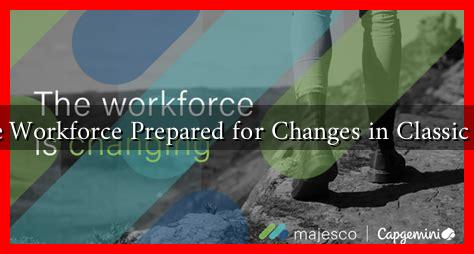-
Table of Contents
- Is the Workforce Prepared for Changes in Classic Jobs?
- The Impact of Technology on Classic Jobs
- Examples of Job Transformation
- Challenges Facing the Workforce
- Strategies for Workforce Preparedness
- 1. Emphasizing Lifelong Learning
- 2. Fostering a Culture of Adaptability
- 3. Collaborating with Educational Institutions
- Conclusion
Is the Workforce Prepared for Changes in Classic Jobs?
As technology continues to evolve at an unprecedented pace, the workforce faces significant changes in classic jobs. Automation, artificial intelligence (AI), and remote work are reshaping traditional roles, leading to questions about whether employees are adequately prepared for these transformations. This article explores the current state of the workforce, the challenges posed by these changes, and the strategies that can be employed to ensure readiness for the future.
The Impact of Technology on Classic Jobs
Classic jobs, such as those in manufacturing, retail, and administrative support, are increasingly being affected by technological advancements. According to a report by McKinsey, up to 800 million jobs worldwide could be displaced by automation by 2030. This statistic highlights the urgency for workers to adapt to new realities.
Examples of Job Transformation
Several industries are experiencing significant shifts due to technology:
- Manufacturing: Robotics and AI are streamlining production processes, reducing the need for manual labor. For instance, companies like Tesla utilize advanced robotics to enhance efficiency.
- Retail: E-commerce has transformed the retail landscape, with traditional brick-and-mortar stores struggling to compete. Amazon’s use of AI for inventory management and customer service exemplifies this shift.
- Administrative Support: Automation tools like chatbots and virtual assistants are taking over routine tasks, leading to a decline in demand for traditional administrative roles.
Challenges Facing the Workforce
While technology offers numerous benefits, it also presents challenges that the workforce must navigate:
- Skill Gaps: Many workers lack the necessary skills to thrive in a tech-driven environment. A report from the World Economic Forum indicates that 54% of all employees will require significant reskilling by 2022.
- Job Displacement: As automation takes over, workers in classic jobs may find themselves unemployed or underemployed. This displacement can lead to economic instability and increased inequality.
- Resistance to Change: Some employees may resist adapting to new technologies, fearing job loss or feeling overwhelmed by the pace of change.
Strategies for Workforce Preparedness
To address these challenges, both employers and employees must take proactive steps to prepare for the future of work:
1. Emphasizing Lifelong Learning
Continuous education and training are essential for workers to stay relevant. Employers can support this by:
- Offering training programs that focus on emerging technologies.
- Encouraging employees to pursue certifications in relevant fields.
- Providing access to online learning platforms, such as Coursera or Udacity.
2. Fostering a Culture of Adaptability
Organizations should cultivate a culture that embraces change. This can be achieved by:
- Encouraging open communication about technological changes.
- Involving employees in the decision-making process regarding new tools and processes.
- Recognizing and rewarding adaptability and innovation.
3. Collaborating with Educational Institutions
Partnerships between businesses and educational institutions can bridge the skills gap. Initiatives may include:
- Internship programs that provide hands-on experience.
- Curriculum development that aligns with industry needs.
- Workshops and seminars led by industry professionals.
Conclusion
The workforce is at a critical juncture as classic jobs undergo significant changes due to technological advancements. While challenges such as skill gaps and job displacement loom large, proactive strategies can help prepare employees for the future. By emphasizing lifelong learning, fostering adaptability, and collaborating with educational institutions, both employers and employees can navigate this evolving landscape successfully. The key takeaway is that preparation is not just an option; it is a necessity for thriving in the future of work.
For further insights on workforce readiness and the impact of technology on jobs, you can explore resources from the World Economic Forum and McKinsey & Company.


